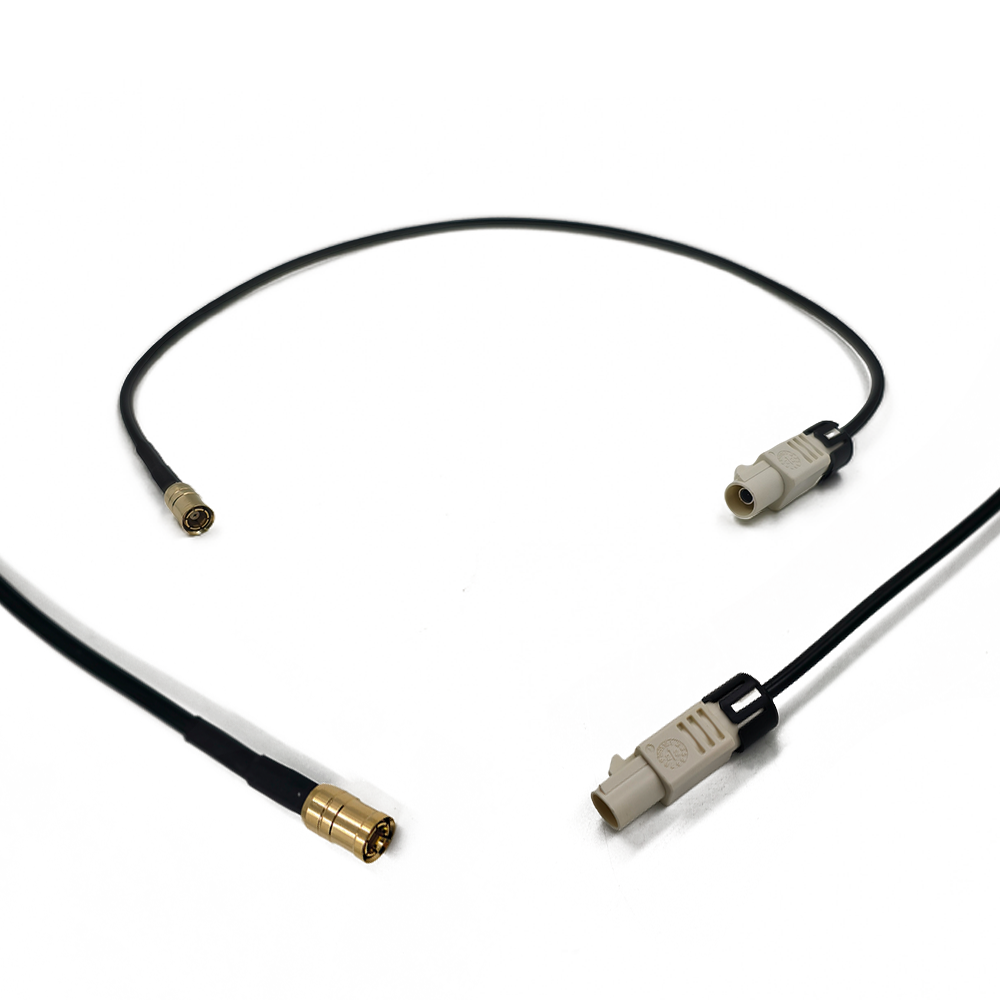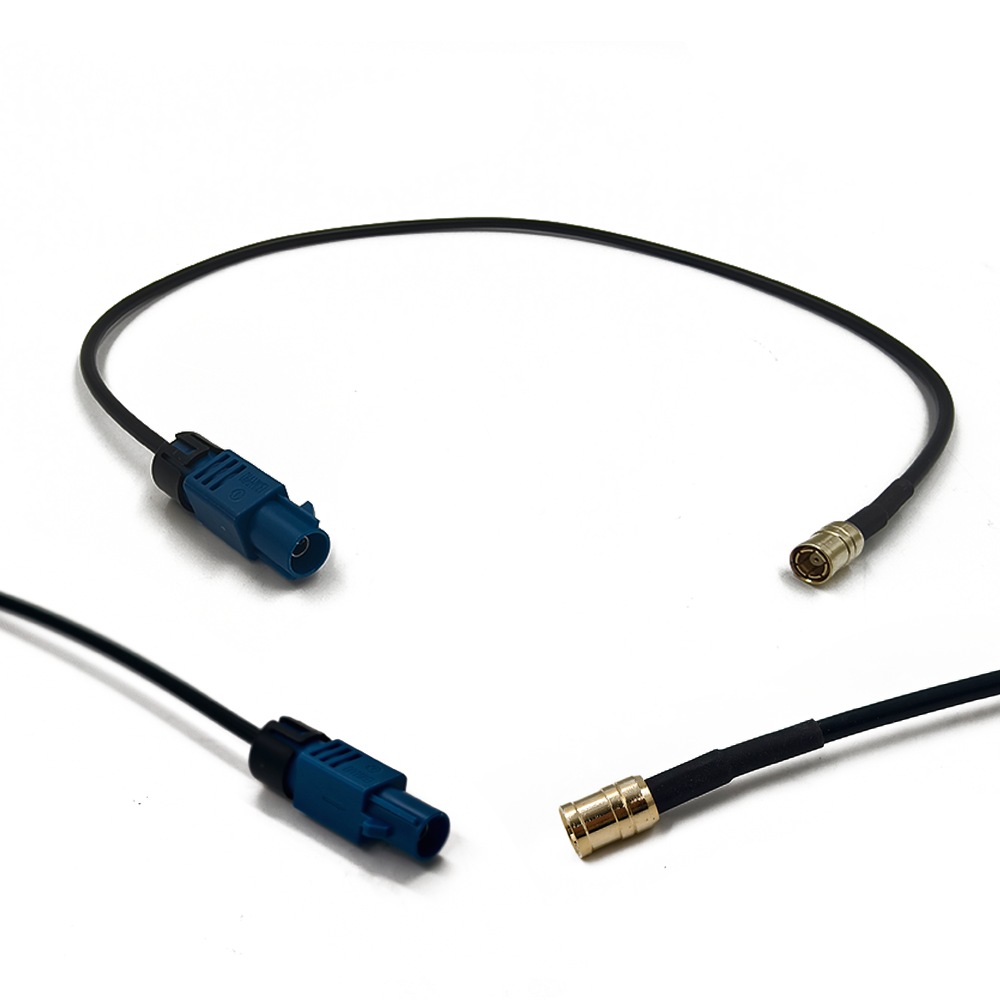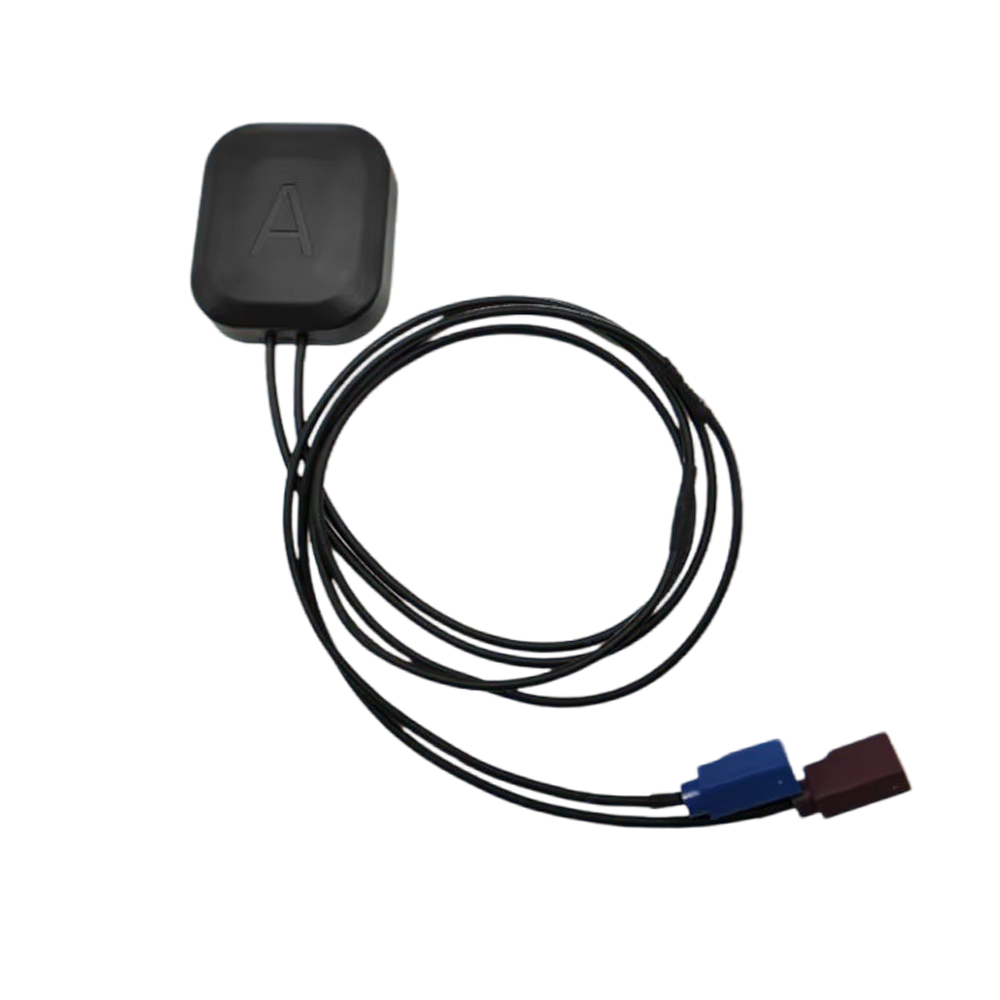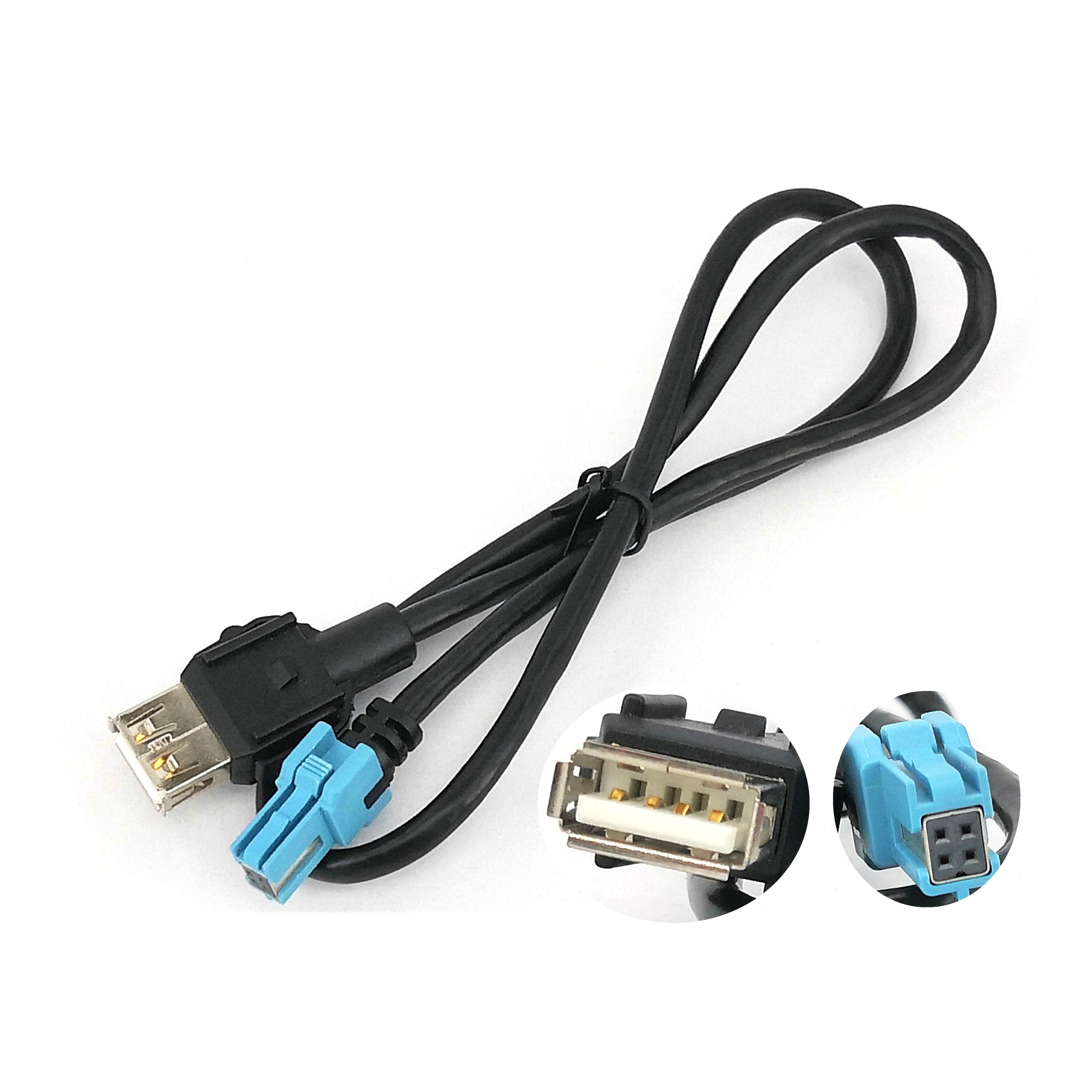GNSS, encompassing satellite constellations such as GPS (United States), GLONASS (Russia), Galileo (Europe), and BeiDou (China), functions by transmitting signals that carry vital information about satellite positions and time stamps. These signals are received by GNSS antennas, which convert the electromagnetic waves into electrical signals that can be processed by in - vehicle receivers. In the automotive context, the accuracy and reliability of GNSS positioning are critical. For instance, precise navigation systems rely on accurate location data to provide drivers with real - time routing information, while ADAS features like lane - keeping assist and adaptive cruise control depend on accurate positioning to operate safely and effectively.
The FAKRA connector plays a pivotal role in this setup. Its design is tailored to meet the stringent requirements of the automotive environment, including resistance to vibrations, temperature variations, and electromagnetic interference. The standardized pin configurations and color - coding system of FAKRA connectors ensure easy identification and compatibility with various in - vehicle components. The bayonet - style locking mechanism provides a secure connection, preventing accidental disconnection during vehicle operation, which could otherwise lead to signal loss and compromise the functionality of GNSS - dependent systems.
Automotive FAKRA connector GNSS antennas are designed to operate effectively in diverse conditions, from urban environments with tall buildings that can cause signal blockage and multipath interference to open highways and remote areas with potential signal weaknesses. By combining the robust FAKRA connector with high - performance GNSS antenna technology, vehicles can maintain stable and accurate positioning, enhancing overall safety, efficiency, and the driving experience. As the automotive industry continues to evolve towards greater connectivity and autonomy, the role of these antennas will only become more critical in enabling advanced features and services.
The design and construction of an automotive FAKRA connector GNSS antenna involve a comprehensive approach that balances performance, durability, and compatibility with automotive systems. Every aspect, from the selection of materials to the integration of components, is carefully engineered to meet the specific demands of the automotive environment.
Antenna Element Design
The antenna element is the core component responsible for capturing GNSS signals. In automotive applications, microstrip antenna designs are widely favored due to their compact size, low profile, and suitability for integration into various vehicle locations, such as the roof, windshield, or dashboard. A microstrip antenna typically consists of a metallic patch, often made of copper or aluminum, placed on a dielectric substrate with a ground plane beneath.
For optimal performance in the GNSS frequency bands, primarily the L1 band at 1.575 GHz and increasingly the L5 band at 1.176 GHz, the shape, size, and configuration of the metallic patch are optimized through electromagnetic simulations. These simulations help engineers determine the best design to achieve high gain, which is essential for effectively capturing weak satellite signals, especially in challenging environments like urban canyons. Good impedance matching is also crucial to minimize signal reflections and maximize power transfer to the receiver. To further enhance performance, additional features such as fractal geometries or parasitic elements may be incorporated into the patch design to improve the antenna's radiation pattern and reduce interference from other in - vehicle components.
The choice of dielectric substrate is a critical decision. Substrates with stable electrical properties over a wide range of temperatures, humidity levels, and frequencies are preferred. Ceramic - based substrates are popular due to their high dielectric constant, which enables miniaturization, and their excellent thermal and mechanical stability, allowing them to withstand the harsh automotive environment. However, other materials like Rogers RT/duroid series may be selected based on specific performance requirements, cost considerations, and the need for flexibility in design.
FAKRA Connector Design
The FAKRA connector is a key element that provides a reliable interface between the GNSS antenna and the in - vehicle receiver or other related equipment. FAKRA connectors are renowned for their compact size, making them ideal for the space - constrained automotive interior. They come in various types, each with a distinct color - coding system that indicates impedance and frequency range, simplifying the identification and selection process during vehicle assembly.
For GNSS applications, the most commonly used FAKRA connectors are designed for 50 - ohm impedance, which is suitable for handling the frequencies associated with GPS, GLONASS, Galileo, and BeiDou signals. The bayonet - style locking mechanism of the FAKRA connector ensures a secure connection, capable of withstanding the vibrations and movements experienced during vehicle operation. This mechanism prevents the connector from accidentally disconnecting, which could lead to signal loss and disrupt the functionality of GNSS - based systems.
The pin configuration of the FAKRA connector is standardized, allowing for seamless integration with a wide range of in - vehicle receivers, navigation systems, and ADAS components. Additionally, the connector's design includes shielding to minimize electromagnetic interference (EMI). In the automotive environment, where numerous electrical components generate EMI, effective shielding is essential to protect the integrity of the weak GNSS signals during transmission between the antenna and the receiver.
Enclosure and Mounting Design
The enclosure of an automotive FAKRA connector GNSS antenna serves to protect the internal components from the harsh automotive environment, which includes exposure to vibrations, temperature fluctuations, moisture, and dust. High - strength engineering plastics or metal alloys are commonly used for the enclosure material. Engineering plastics offer good impact resistance, UV resistance, and chemical resistance, while metal alloys provide excellent electromagnetic shielding and mechanical strength.
The antenna's mounting design is carefully considered to ensure stable operation during vehicle movement. Roof - mounted antennas are often designed with aerodynamic shapes to minimize wind resistance and noise. They are securely attached to the vehicle roof using adhesive tapes, screws, or specialized mounting brackets that can withstand vibrations and aerodynamic forces. Windshield - mounted antennas, on the other hand, are integrated into the windshield glass during the manufacturing process, using techniques such as printed antenna technology. This approach not only provides a discreet installation but also ensures optimal signal reception while maintaining the structural integrity of the windshield.
Assembly and Integration
The assembly of an automotive FAKRA connector GNSS antenna involves carefully combining the antenna element, the FAKRA connector, and the enclosure. During assembly, strict quality control measures are implemented to ensure that all components are properly aligned and that the FAKRA connector is securely attached to the antenna. The antenna is then integrated into the vehicle's electrical system, which may involve routing the FAKRA - connected cable through the vehicle's interior or exterior, depending on the antenna's location.
Integration with the in - vehicle receiver and other systems requires careful consideration of signal routing, shielding, and compatibility. The FAKRA - connected cable must be routed in a way that minimizes interference from other electrical components and ensures a stable signal transmission. Additionally, the antenna system needs to be compatible with the vehicle's communication protocols and power supply requirements, ensuring seamless operation within the overall automotive electronics ecosystem.
Working Principles
The working principles of an automotive FAKRA connector GNSS antenna involve a series of coordinated processes that enable the antenna to capture, transmit, and process GNSS signals accurately, ultimately providing the vehicle with precise positioning information.
Signal Reception
The operation of the antenna commences with the antenna element capturing the weak radio - frequency signals transmitted by GNSS satellites. These signals, which carry information about the satellite's position and time, travel through the Earth's atmosphere before reaching the antenna. The antenna element, designed to resonate at the GNSS frequencies, efficiently couples with the incoming signals and converts the electromagnetic energy of the GNSS signals into electrical signals.
When the frequency of the incoming GNSS signals matches the resonant frequency of the antenna element, a resonance effect occurs. This resonance enhances the antenna's ability to absorb the energy of the signals, generating electrical currents that represent the received GNSS signals. However, in the real - world automotive environment, these initial signals are often subject to various impairments. For example, in urban areas, tall buildings can cause signal blockage and multipath interference, where signals reach the antenna via multiple reflected paths. In addition, ionospheric delays, tropospheric delays, and satellite clock inaccuracies can also distort the signals, affecting the accuracy of the positioning calculations.
Signal Processing and Transmission
The weak electrical signals received by the antenna element are then processed and transmitted to the in - vehicle GNSS receiver through the FAKRA connector. Before transmission, the signals may pass through a series of components within the antenna, such as a low - noise amplifier (LNA) and filters.
The LNA boosts the weak GNSS signals to a level suitable for further processing while minimizing the addition of noise. This is crucial because the signals received from the satellites are extremely weak, and any additional noise could significantly degrade the accuracy of the positioning calculations performed by the GNSS receiver. After amplification, the signals pass through filters, including band - pass filters, which allow only the frequencies within the GNSS bands to pass through while rejecting unwanted frequencies and interference from other in - vehicle electrical components, such as the engine control unit or the entertainment system.
The FAKRA connector plays a vital role in transmitting the processed signals from the antenna to the receiver. Its secure connection and shielding properties ensure that the signals are transmitted without significant loss or interference. The standardized pin configuration of the FAKRA connector allows for a consistent and reliable connection, enabling the GNSS receiver to receive the signals accurately for further processing.
Position Calculation
Once the GNSS receiver receives the signals from the FAKRA - connected antenna, it initiates the process of position calculation. The receiver analyzes the time it takes for the signals to travel from the satellites to the antenna. By knowing the positions of the satellites (which are continuously transmitted in the GNSS signals) and the time delays, the receiver can use the principle of trilateration to calculate the distance between the antenna (and thus the vehicle) and each satellite.
Using the distances to multiple satellites, the GNSS receiver can determine the precise position of the vehicle on Earth's surface, along with other information such as altitude, speed, and heading. In more advanced systems, additional correction data from reference stations, as in the case of Real - Time Kinematic (RTK) positioning, may be used to further enhance the accuracy of the position calculation. This accurate positioning information is then used by various in - vehicle systems, such as navigation systems, ADAS, and autonomous driving systems, to provide services and functions that improve safety, efficiency, and the overall driving experience.
-
Advantages
One of the most significant advantages of automotive FAKRA connector GNSS antennas is their high - reliability in providing accurate positioning. The combination of the robust FAKRA connector and the optimized GNSS antenna design ensures stable signal reception, even in challenging environments. The secure connection provided by the FAKRA connector's bayonet - style locking mechanism prevents signal loss due to vibrations or accidental disconnection, which is crucial for maintaining the functionality of GNSS - dependent systems in vehicles.
These antennas also offer excellent compatibility with a wide range of automotive electronics. The standardized FAKRA connector system allows for easy integration with different in - vehicle receivers, navigation systems, and ADAS components. This compatibility simplifies the vehicle manufacturing and assembly process, as well as the upgrade and maintenance of GNSS - related systems. Additionally, the ability to receive signals from multiple GNSS constellations, such as GPS, GLONASS, Galileo, and BeiDou, enhances the reliability and accuracy of positioning, providing redundancy in case of signal outages from a particular constellation.
Automotive FAKRA connector GNSS antennas are designed to withstand the harsh automotive environment. The enclosure materials and sealing mechanisms protect the internal components from moisture, dust, temperature fluctuations, and vibrations. This durability ensures a long service life for the antenna, reducing the need for frequent replacements and maintenance, which in turn lowers the overall cost of ownership for vehicle manufacturers and owners.
Challenges
Despite their numerous advantages, automotive FAKRA connector GNSS antennas face several challenges. One of the primary challenges is the issue of electromagnetic interference (EMI). In modern vehicles, there are numerous electrical components, such as electric motors, inverters, and communication modules, that generate EMI. This interference can disrupt the weak GNSS signals, leading to positioning errors or signal loss. Designing effective shielding and filtering mechanisms to mitigate EMI while maintaining a compact antenna design is a complex engineering challenge.
Another challenge is related to the cost. The development and production of high - performance automotive FAKRA connector GNSS antennas involve advanced materials, precise manufacturing processes, and rigorous testing. The use of specialized FAKRA connectors, high - quality antenna elements, and durable enclosures contribute to the overall cost of the antenna. Reducing costs without sacrificing performance and reliability is a constant struggle for manufacturers, especially in a highly competitive automotive market.
Compatibility with emerging automotive technologies also poses a challenge. As the automotive industry evolves towards electric vehicles (EVs), connected cars, and autonomous driving, new requirements for GNSS antennas emerge. For example, in EVs, the presence of high - voltage electrical systems can generate additional EMI, requiring enhanced shielding and signal processing capabilities. Ensuring that automotive FAKRA connector GNSS antennas can seamlessly integrate with these new technologies and meet their performance requirements is an ongoing challenge for the industry.
-
Applications
Automotive FAKRA connector GNSS antennas have a wide range of applications in modern vehicles. In - vehicle navigation systems are one of the most common applications. These antennas provide accurate positioning data that enables navigation systems to offer real - time routing information, traffic updates, and point - of - interest guidance to drivers. The accuracy of the positioning data is crucial for providing reliable navigation, especially in complex urban environments.
Vehicle tracking and fleet management also rely heavily on these antennas. By accurately tracking the location of vehicles, fleet operators can optimize routes, monitor vehicle usage, and improve overall fleet efficiency. This is particularly important for logistics companies, delivery services, and rental car agencies.
Advanced driver - assistance systems (ADAS) use the positioning information provided by GNSS antennas for functions such as lane - keeping assist, adaptive cruise control, and blind - spot detection. Accurate positioning is essential for these safety - critical features to operate effectively, helping to prevent accidents and improve road safety. In the emerging field of autonomous driving, precise GNSS positioning, combined with other sensors such as lidar and cameras, is fundamental for the safe operation of self - driving vehicles.
Future Trends
Looking ahead, several future trends are expected to shape the development of automotive FAKRA connector GNSS antennas. One trend is the integration of multi - band and multi - constellation capabilities. As more GNSS constellations become operational and new frequency bands are utilized, antennas will need to be designed to receive signals from multiple bands and constellations simultaneously. This will further enhance the accuracy, reliability, and availability of positioning information, especially in challenging environments.
The incorporation of artificial intelligence (AI) and machine learning (ML) algorithms is another emerging trend. AI and ML can be used to optimize the performance of GNSS antennas in real - time. These algorithms can analyze the received signals, detect changes in the signal environment, and adjust the antenna's operation parameters, such as gain and filtering, to adapt to different conditions. For example, AI can be used to predict and mitigate the effects of interference, improving the accuracy of positioning.
Advancements in communication technologies, such as 5G, will also impact the design and use of automotive FAKRA connector GNSS antennas. 5G's high - speed, low - latency communication capabilities can enable faster and more reliable transmission of GNSS correction data, further enhancing the accuracy of positioning. Antennas will need to be designed to work in harmony with 5G communication systems, enabling seamless integration of positioning and communication functions in future vehicles.
There is also a trend towards the development of more compact and integrated antenna solutions. As vehicles become more electrified and autonomous, space within the vehicle is at a premium. Future automotive FAKRA connector GNSS antennas will likely be designed to be smaller, lighter, and more integrated with other vehicle components, such as the vehicle's body or windshield, without sacrificing performance.
Conclusion
Automotive FAKRA connector GNSS antennas are essential components in modern vehicles, enabling accurate positioning for a wide range of applications, from navigation and vehicle tracking to ADAS and autonomous driving. Their reliable connection provided by the FAKRA connector and high - performance antenna design make them well - suited for the harsh automotive environment.
However, challenges such as electromagnetic interference, cost, and compatibility with emerging technologies need to be addressed. As the automotive industry continues to evolve, future trends such as multi - band and multi - constellation integration, the use of AI and ML, compatibility with 5G, and the development of more compact antenna solutions offer great potential for enhancing the performance and capabilities of these antennas. By overcoming these challenges and embracing these trends, automotive FAKRA connector GNSS antennas will continue to play a crucial role in shaping the future of connected, safe, and autonomous vehicles.




































































 Language
Language
 En
En Cn
Cn Korean
Korean

 Home >
Home > 








 18665803017 (Macro)
18665803017 (Macro)













